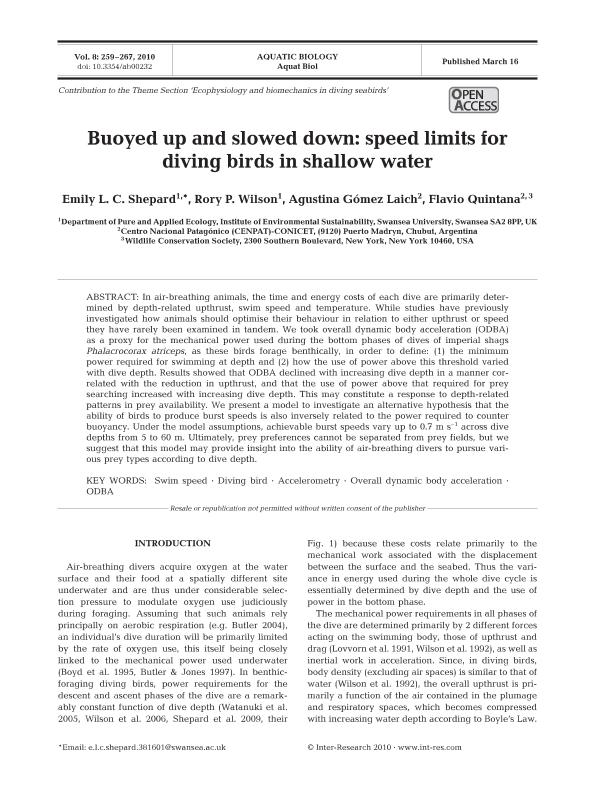Mostrar el registro sencillo del ítem
dc.contributor.author
Shepard, Emily L. C.
dc.contributor.author
Wilson, Rory P.

dc.contributor.author
Gómez Laich, Agustina Marta

dc.contributor.author
Quintana, Flavio Roberto

dc.date.available
2018-10-29T12:45:55Z
dc.date.issued
2010-03
dc.identifier.citation
Shepard, Emily L. C.; Wilson, Rory P.; Gómez Laich, Agustina Marta; Quintana, Flavio Roberto; Buoyed up and slowed down: Speed limits for diving birds in shallow water; Inter-Research; Aquatic Biology; 8; 3; 3-2010; 259-267
dc.identifier.issn
1864-7782
dc.identifier.uri
http://hdl.handle.net/11336/63163
dc.description.abstract
In air-breathing animals, the time and energy costs of each dive are primarily determined by depth-related upthrust, swim speed and temperature. While studies have previously investigated how animals should optimise their behaviour in relation to either upthrust or speed they have rarely been examined in tandem. We took overall dynamic body acceleration (ODBA) as a proxy for the mechanical power used during the bottom phases of dives of imperial shags Phalacrocorax atriceps, as these birds forage benthically, in order to define: (1) the minimum power required for swimming at depth and (2) how the use of power above this threshold varied with dive depth. Results showed that ODBA declined with increasing dive depth in a manner correlated with the reduction in upthrust, and that the use of power above that required for prey searching increased with increasing dive depth. This may constitute a response to depth-related patterns in prey availability. We present a model to investigate an alternative hypothesis that the ability of birds to produce burst speeds is also inversely related to the power required to counter buoyancy. Under the model assumptions, achievable burst speeds vary up to 0.7 m s–1 across dive depths from 5 to 60 m. Ultimately, prey preferences cannot be separated from prey fields, but we suggest that this model may provide insight into the ability of air-breathing divers to pursue various prey types according to dive depth.
dc.format
application/pdf
dc.language.iso
eng
dc.publisher
Inter-Research

dc.rights
info:eu-repo/semantics/openAccess
dc.rights.uri
https://creativecommons.org/licenses/by-nc-sa/2.5/ar/
dc.subject
Accelerometry
dc.subject
Diving Bird
dc.subject
Odba
dc.subject
Overall Dynamic Body Acceleration
dc.subject
Swim Speed
dc.subject.classification
Otras Ciencias Biológicas

dc.subject.classification
Ciencias Biológicas

dc.subject.classification
CIENCIAS NATURALES Y EXACTAS

dc.title
Buoyed up and slowed down: Speed limits for diving birds in shallow water
dc.type
info:eu-repo/semantics/article
dc.type
info:ar-repo/semantics/artículo
dc.type
info:eu-repo/semantics/publishedVersion
dc.date.updated
2018-10-12T18:04:56Z
dc.identifier.eissn
1864-7790
dc.journal.volume
8
dc.journal.number
3
dc.journal.pagination
259-267
dc.journal.pais
Alemania

dc.journal.ciudad
Oldendorf/Luhe
dc.description.fil
Fil: Shepard, Emily L. C.. Swansea University; Reino Unido
dc.description.fil
Fil: Wilson, Rory P.. Swansea University; Reino Unido
dc.description.fil
Fil: Gómez Laich, Agustina Marta. Consejo Nacional de Investigaciones Científicas y Técnicas. Centro Nacional Patagónico; Argentina
dc.description.fil
Fil: Quintana, Flavio Roberto. Consejo Nacional de Investigaciones Científicas y Técnicas. Centro Nacional Patagónico; Argentina. Wildlife Conservation Society; Estados Unidos
dc.journal.title
Aquatic Biology

dc.relation.alternativeid
info:eu-repo/semantics/altIdentifier/doi/http://dx.doi.org/10.3354/ab00232
Archivos asociados
